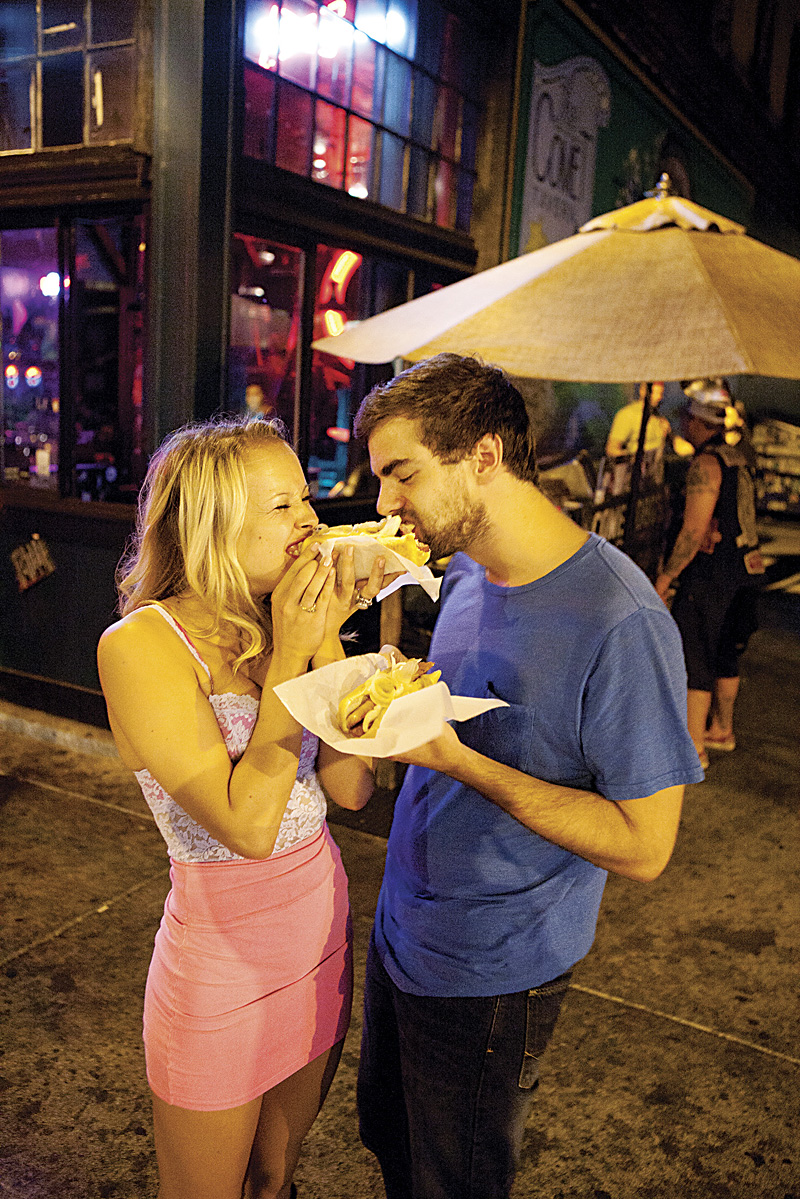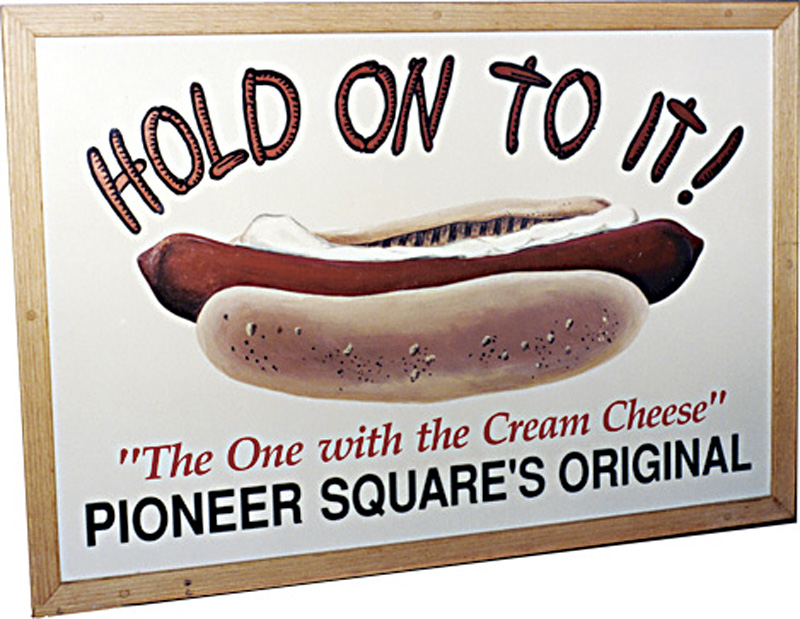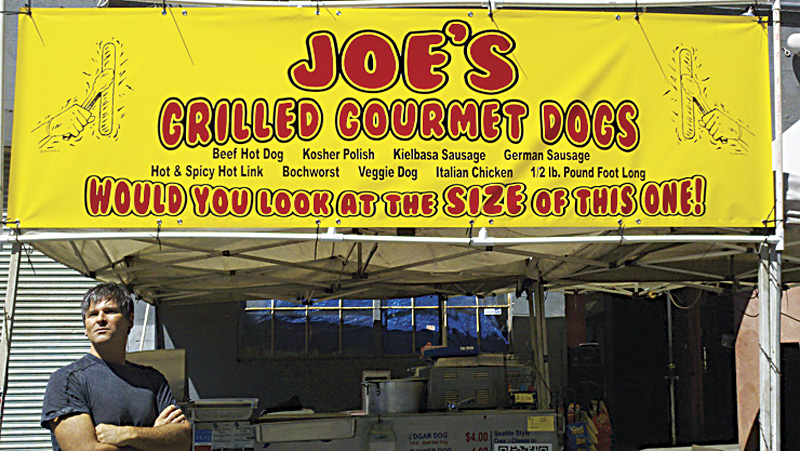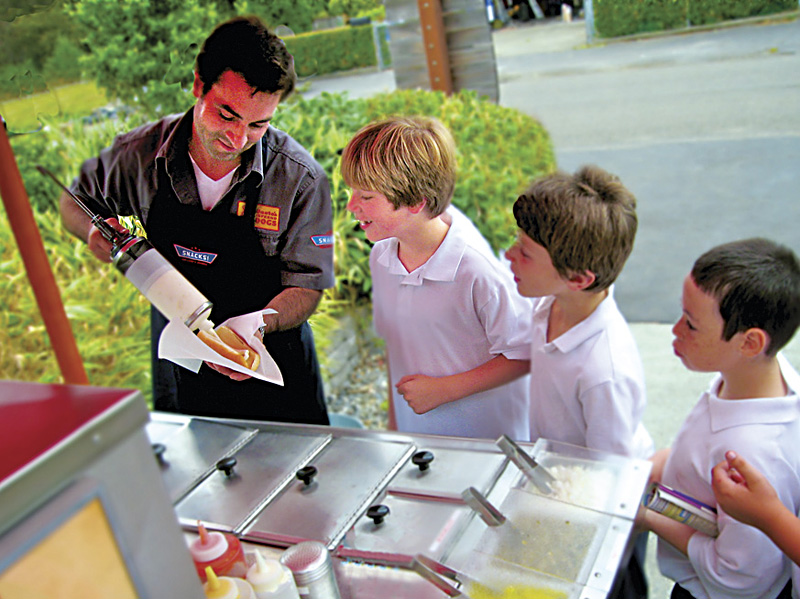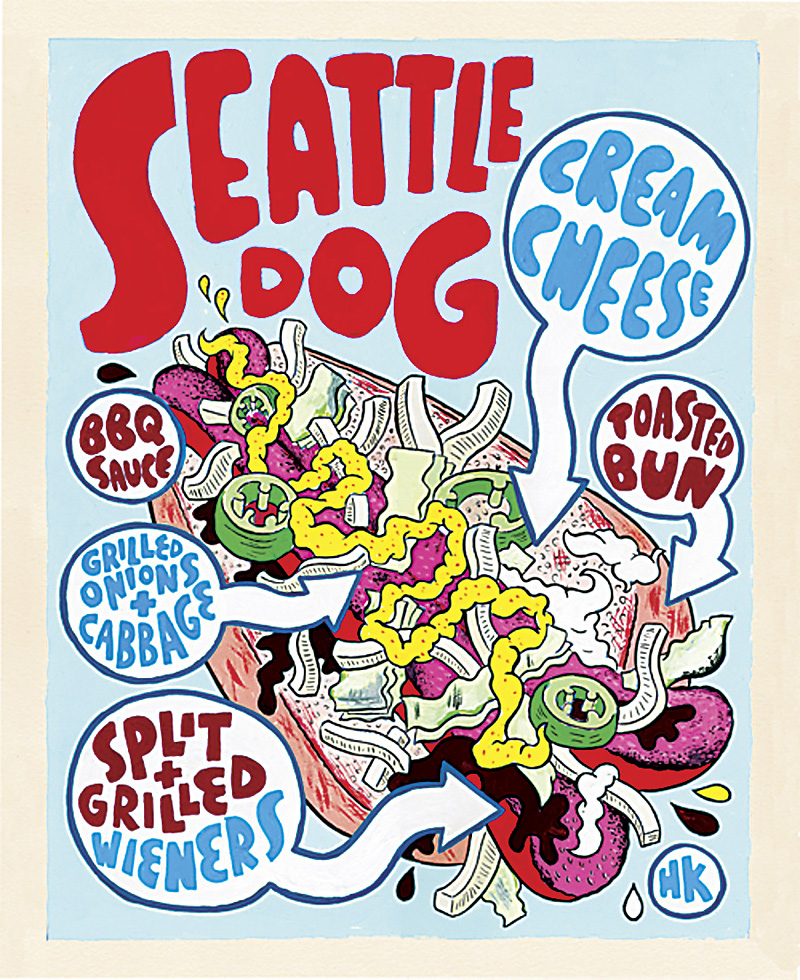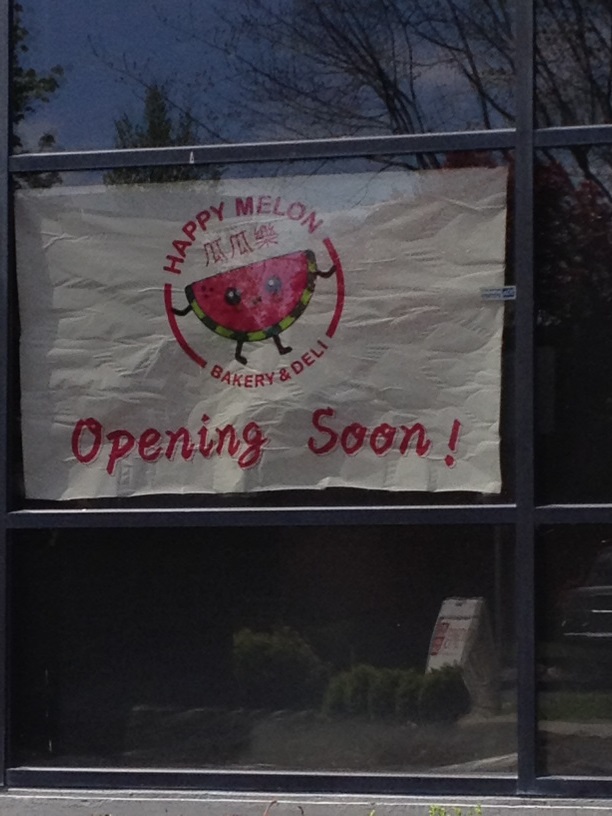Related video: The making of a Seattle Dog at Safeco Field
Slathering cream cheese on hot dogs is a notion that rose from the streets, not recipe books. Bonnie Slotnick, owner of the esteemed Greenwich Village antiquarian cookbook shop that bears her name, isn’t aware of any books that endorse the preparation, which she calls “extremely deviant.”
Likewise, Kraft Foods, producer of Philadelphia cream cheese and Oscar Mayer hot dogs, has no record of ever suggesting its customers combine the two; the very idea was considered so bizarre that a 1979 employee publication listed cream cheese alongside such outlandish toppings as mashed avocados, applesauce, and peach pie filling.
But for Seattle eaters, there’s nothing silly about the cream-cheese dog. Safeco Field added the Seattle Dog to its menu four years ago, and vendors outside the stadium on game days sell thousands of dogs garnished with cream cheese—at least when health-department inspectors aren’t looking. Seller Joe Bernstein estimates that as many as seven of every 10 customers take their sausages with a schmear. It’s the city’s signature drunk food, sold from carts which congregate in Belltown, Ballard, and at the corner of 10th and Pike.
The Seattle Dog is 24 years old, but most fans are unclear on its life story. Here, in the words of the vendors who served the dogs and the customers who devoured them, is the previously untold tale of how an Ohioan collaborated with a Capitol Hill bakery to create the only food to bear the city’s name.
WHAT IS A SEATTLE DOG?
JOE BERNSTEIN opened Joe’s Grilled Gourmet Hot Dogs on Occidental Avenue South in 1998.
A Seattle Dog is, obviously, cream cheese and onions. We’re not like the East Coast. East Coast is mustard and kraut. New Yorkers, they walk up and go “Yeah, I’ll take a hot dog with kraut.” And I’ll say, “And cream cheese?” They look at me like, “Cream cheese?”
FARSHID VARAMINI opened Pioneer Grill Hot Dogs on Occidental Avenue South in 1998.
People say, “What is that? It doesn’t sound right.” I say, “If you don’t like it, bring it back.” I have not yet had one customer bring one back.
DOROTHY BALLANTYNE lives in Brooklyn. Bernstein three years ago persuaded her to try her first Seattle Dog.
We were like “All right, we’ll give it a go,” and we all loved it. It sounds like such an odd mixture, but it really is good. I tried to convince them in New York, but they’re not very flexible.
GARRETT MORLAN is a Seattle graphic designer.
I moved from New York City about three years ago, and the hot-dog vendors—although they’re world-famous in New York—they’re terrible. I moved to lower Queen Anne and, obviously, being close to Belltown, I used to go down to the Lava Lounge and the Crocodile. That’s how I came upon it, late-night and hungry. You’ve had a few drinks, a hot dog sounds great. I was kind of blown away by the mixture of cream cheese, and being able to put different things on it, like jalapeños or Sriracha or barbecue sauce. I thought it was amazing.
JEFF LEONARD is a bartender and Seattle Dog slinger at the Comet Tavern.
I’m doing it for four-and-a-half years, and I can’t stop eating them. They’re not bad for you: They cover four of the five basic food groups. You’ve got your bread; you’ve got your onion; you’ve got your dairy, with the cream cheese; and you’ve got your meat.
Bernstein: [Former KIRO announcer] New York Vinnie, he came down during a football game. I showed the dog with cream cheese, and he put it on TV, and everybody goes, “I don’t know if I can eat that ’cause I’m on Lipitor.” And then the ex-Seahawk in the booth—remember, we’re live on TV—he goes, “Hey, don’t worry about it, Vinnie. Bring that cream-cheese dog up to me.”
Varamini: Oh, it’s my favorite. I think it’s just different. When you grow up, you’re used to the Oscar Mayer dog with ketchup, mustard—the Costco dog. The Seattle Dog has got so many different flavors: the creaminess of the cheese and the sweetness of the onions.
KEITH GARABEDIAN last year opened Hot Diggity, a high-end hot-dog shop, in Philadelphia.
I think it’s the balance of three things. Texturally, it’s the meat of the hot dog and the cream of the cream cheese. There’s also a hot/cold element: The hot dog’s hot and the cream cheese is usually kind of cold. And then the hot dog is really savory and cream cheese is kind of on the sweet side, so it’s got a couple of different things that are in balance, playing off each other really well.
Bernstein: People want the cream-cheese dog; it’s that serious. Once you get cream cheese, you never go back.
WHO INVENTED IT?
MARIO TOTTEN owns the domain name seattlebageldog.com.
In the late 1990s, I used to go down to Pioneer Square with everybody, and they had a cart that would sell this creation called the bagel dog. People would line up and buy these dogs, and they would sell out quickly, like by 10 p.m. They started the craze because other stands couldn’t source the same rolls. It’s very distinct; I think it’s called a bialy stick.
DANTE RIVERA opened his first Dante’s Inferno Dogs cart in 2000.
The story I know is there was a guy down at Pioneer Square years ago who would butterfly all of his hot dogs and serve them on day-old bagels.
DALE JONES is the owner of Bagel Deli, a 32-year-old Capitol Hill bakery.
A bialy is actually bagel dough that’s not boiled, but it’s shaped like a hot-dog bun, and it’s got rolled onions on it. We used to put poppy seeds on it, but people kind of shied away from poppy seeds because of drug testing, so now we just do onions. If you’re in New York or Philadelphia, typically they’ll have a traditional round bialy that’s like a bagel, but it’s got a flat bottom on it. And then there are bialy sticks. We do the stick here.
HADLEY LONGE now manages Tony’s on the Lake, an Italian supper club in Coeur d’Alene, Idaho. A bagel peddler in Longe’s hometown of Athens, Ohio, inspired him to start selling bagels in 1977 when he moved to Carbondale, Ill., to enroll in Southern Illinois University.
I opened up my first bagel shop in Carbondale. It was a small college town, kind of like Bellingham. So after about seven years, I was like the big fish in the small pond, and I was wanting to see if I could do it in the big pond. In the late ’80s, Seattle was the place to be, art and music and everything, so I moved to Seattle and I was the bagel man.
Longe arrived in Seattle in 1988. He got a job at the Bagel Express in Pioneer Square, and asked the owner’s permission to operate a hot-dog cart at night. His cart was in full swing by 1989, when the Kingdome hosted the Final Four.
Longe: I got started just doing vegetarian bagels on the street, with raisins, cucumbers, onions, sprouts, sunflower seeds. After about a year of doing these veggie bagels, everybody wanted hot dogs. That was just something I didn’t want to do, so I thought I would incorporate my bagel and cream cheese into a hot dog. And I was just fortunate enough that the Bagel Deli created very unique bialy sticks. They’re all hand-rolled and they’re all custom, and I kind of just created the bagel dog with cream cheese.
I didn’t want to be a hot-dog guy. I wanted to be the bagel man. So even though I sold hundreds of bagel dogs, I always waited for the person who would still want a veggie bagel.
Jones: It was crazy. He was selling hot dogs like nobody’s business. If you’ve eaten a Costco dog, you know what they’re like, but if you can imagine that plus something a little extra, and you put that on a bialy stick, it’s a pretty good hot dog.
Longe: I would tell everybody, “Two hands, hold on to it.” The cream cheese would always make [the hot dogs] slide out of there, so that’s why every single person, I’d have to tell. I had one guy, he called the cream cheese “glue,” and he’d always say “extra glue.” And I would put it on both sides of the bialy stick. It was pretty much an overnight sensation. I was doing so well, three other bars on my block opened up hot-dog stands: The J&M, The Central, and Larry’s. I don’t know if they were jealous or what.
OTMANE BEZZAZ sold bagels in New York before moving to Seattle. He currently owns J&M Cafe in Pioneer Square and two locations of Mediterranean Mix.
I came to Seattle in 1993 and set up a stand selling hot dogs in Pioneer Square. I never thought about putting cream cheese on a hot dog, but I was selling cream-cheese bagels, and then one time, I put cream cheese on the hot dogs and the customer liked it. I’m the one who first had the idea to put the dog on the cream cheese. Now everybody is doing it and I get no credit.
Bernstein: Everybody seems to think that they’ve been doing cream cheese forever. Once you get to know everybody, it’s funny.
Longe: Imitation is the best form of flattery.
But the imitation wasn’t precise: Other vendors soon traded their bagel rolls for standard hot-dog buns.
Totten: You’d buy it and it was on a regular steam roll. You’re like, “This doesn’t seem like the regular thing.”
Bezzaz: It was hard for us to sell the bagels because the bagel cannot stay over one day. I was using the bialy, but the crowd of Pioneer Square change, and the new customer find the bread is hard, so we switch to regular hoagie bun.
Longe moved to Idaho in 1999. He still has his cart, although he’s never again sold hot dogs.
Longe: It was so unique down there. Pioneer Square was such a special place. Back then, it was on the cusp of grunge and on the cusp of Starbucks and coffee and Microsoft. There was so much diversity in Pioneer Square. There was just so much music down there. And the nightlife, it was just revelry and fun.
The grunge years, that was probably one of my favorite things. All those grunge bands that made it, they came and ate with me, and they were just normal guys, all of them. They’re selling millions and millions of records, but you couldn’t tell. They’d just hang out: Caring individuals, you know, staying true to their roots, which was Pioneer Square.
BUT HOW DID THE DOG BECOME SO POPULAR BEYOND PIONEER SQUARE?
Bezzaz: At the Showbox, we opened a location in 1997. I brought the cream-cheese dogs.
CHAD QUEIROLO is a concert promoter at the Showbox. In 2007, he and Jeff Steichen sold the downtown club to AEG Live.
The cream-cheese hot dog was a huge phenomenon when I started at the Showbox in 1999. Everyone loved them. I loved them. I was once hit in the face with a Seattle Dog at a Pearl Jam show in 2002, as people were so upset that we couldn’t let more people in the Showbox to an obviously beyond-sellout show.
JEFF LEONARD is a bartender at the Comet Tavern.
Six, seven years ago, maybe, a man named Said worked with the guy down at the Mediterranean Mix. Then he started his own [stand]; he brought it up to Capitol Hill. The stand was owned by Said, but he rented the space from the Comet. The owner of the Comet decided, “Hey, I see what’s going on here, I want to make some money myself.” He kicks Said out; Said moves across the street and opens one up over at Neumos. So there’s stand one at Retrofit, stand two at Poquito’s, stand three here at the Comet, stand four at Neumos, stand five at the gas station. Not including the ones by Linda’s—and there’s one down from that.
Bernstein: When was the big boom? Everybody started having it around 2001, because that’s when hot dogs went crazy. Why did hot dogs go crazy? Because we had the Mariners doing freaking awesome, and we had the All-Star Game. Hot-dog stands around the stadium just started booming. It really took off because of the volume of people coming. We had the new stadium in [1999]. Hot-dog stands just popped up around Safeco Field like weeds, literally.
ANDY SPERRY is the owner of Seattle Shuttle.
We pick up people from local hotels up by the Space Needle and we take them down to ball games. We used to drop them off right there by Joe’s stand. My favorite was the Buhner Dog [with] raw onions. One day, I’m at home and we have one of those cream-cheese packets. And I was like, “Gee, I wonder how this would taste.” It was a packet of opportunity, I guess you’d call it.
Joe looked at me, and I was spreading this cream cheese on the Buhner dog, and he was like, “What are you doing?” I was like, “Taste it.” And he was like, “Wow, that’s pretty good.” I’m not Seattle’s Mr. Cream Cheese, obviously, but you just try different combinations. [My wife] Melinda and I are foodies. We’ve tried cream cheese on lots and lots of different things. Some of those things you would never dream it goes with. Have you ever tried a burrito with cream cheese? It mellows the sharpness of the taco meat right out.
Bernstein: What else can I sell to go on a hot dog and make some money? “I’ll take a Polish sausage.” “Did you want onions on that?” “Yep.” “How about cream cheese, you wanna add cream cheese on there?” And there we go.
Everyone thinks I invented it, but I didn’t. I am one of the first ones who put on the sign “Seattle-style,” I can guarantee you that. Because everybody walks up and asks for Chicago-style, I named it Seattle-style. I don’t remember copying anyone.
HOW DO VENDORS MAKE SO MANY SEATTLE DOGS SO QUICKLY?
Rivera: I cannot take credit for the cream-cheese dog, it’s been around much longer than I. Now the caulking gun, that is my one claim to fame. When I first went into the hot-dog business, I didn’t really do my research. I knew what I wanted, what I liked, and I was going to go forward with that. And within my first weekend of slinging dogs, people kept mentioning cream cheese. I heard it so much, literally, my first or second night of serving dogs, I went out and I purchased myself a tub of cream cheese and a spreading knife and went to town.
Bernstein: We use the big five-pound bucket.
Rivera: It’s so messy, so time-consuming. Hot-dog vendors, we make our money in multiple units, so if you’re slowing down to schmear cream cheese on a toasted hot-dog bun with the potential of the bun tearing . . .
MICHAEL ANDERSON has run M.A.’s Gourmet Dogs in Anchorage, Alaska, for 20 years. USA Today named it one of the top 10 stands in the country.
Speed is essential. If I’m delaying each customer by 10, 15 seconds—times 30 people—that adds up.
Rivera: I was thinking there has to be a better way. And I literally got out of bed one night and went to a 24-hour drive-thru at the Ballard Taco Bell, up there on 15th. They have those sauce guns that they [use to] shoot out the sour cream and guacamole, and that’s where I got the idea. I remember asking for the Taco Bell manager at 1 o’clock in the morning because I wanted to buy it directly from him, right through the window. He said, “Sorry, dude. You’re going to have to hit a restaurant-supply store.” That’s exactly what I did the very next morning.
Rivera purchased a Prince Castle condiment dispenser, but he was squeezing so much hard cream cheese through a soft-foods tool that he was forced to replace it almost immediately. He eventually designed a customized cream-cheese gun that he sells to vendors for $350, while other hot-doggers have fashioned cheaper solutions to the application quandary.
DAVE PLANTE operates Dave’s New England Coneys in Renton.
I found a cupcake-decorating tool and modified it. It puts out a nice even stream, and people just love it. I think it’s called Dessert Pro or something like that; it’s found at Bed Bath & Beyond. We have the cart equipped with two of these guns, so when we go to bigger events, both of them are loaded and ready to go. But you can’t use regular cream cheese—you have to use whipped.
Rivera: Whipped cream cheese, to me, has a totally different flavor. It’s completely different. A lot of it has to do with the way it melts. And also, you have to remember that people are most comfortable with what they’re familiar with, and they grew up on actual cream cheese.
Plante: The only problem that I’ve found is I’ve known of two people who are using the guns who have been told by the health department, “You’ve gotta go to packets.”
Bernstein: The health department doesn’t like cream cheese. It’s still taboo. Isn’t that crazy? Our hot-dog carts are licensed to sell FDA-approved, precooked hot dogs. You can’t sell anything else off it. Technically, you’re not even supposed to have a veggie dog. And you have to have veggie dogs in Seattle.
PHIL WYMAN is a health and environmental investigator for the Public Health Department of Seattle and King County. He’s never had a Seattle Dog.
They’re allowed to have cream cheese as long as it’s in individual packets. They can go with a tub, but they’ll have to upgrade the permit, which they probably don’t want to do just for cream cheese.
Rivera: You have to remember that in today’s economy, it’s another way to generate revenue. So it’s only recently that the health inspectors have actually started to fine. I’m not saying that the health inspectors don’t want to ensure public safety, but they have looked the other way for a number of years.
Wyman: Cream cheese is not one of the things we’re really focused on. We spend most of our time talking to people about hand-washing, not working when you’re sick, and so forth. Singling out a single food like cream cheese, we don’t really do that.
Bernstein: They know they’re damned if they do and they’re damned if they don’t, because if cream cheese isn’t on the menu, it would destroy the industry. I guarantee it.
SO IT’S A REAL THING?
As best as the crack staff at the Seattle Public Library can determine, Seattle Dogs were first mentioned in print by The Stranger, which in 1999 briefly reviewed Bezzaz’s cart. “They make something which, when I first heard it described, sounded repulsive, but turned out to be sublime: The cream-cheese hot dog,” Traci Vogel wrote. “This hot dog, nicely cooked, appears in a crispy bun smeared with cream cheese.”
The first national publication to take notice was the Serious Eats blog; in 2009, hot-dog columnist Hawk Krall made the “Seattle-style cream-cheese dog” his hot dog of the week.
Morlan: Hawk and I went to art school together in Brooklyn. I just kept up with him, and I said, “You have to [write about] the Seattle Dog.”
Krall: Garrett said, “Hey, they have hot dogs here with cream cheese on them.” I said, “Oh, I never heard of that. Sounds crazy.” So he sent me some pictures. I’ve never actually been to Seattle and eaten one of these things, but I definitely looked into it, and after that article, people said “This is not real!”
RICK SEBAK is a documentary producer at WQED in Pittsburgh. His 1999 A Hot Dog Program, which remains in heavy rotation on PBS stations, is considered the seminal hot-dog doc.
What’s a Seattle Dog? I don’t even know . . . That sounds terrible.
The Bagel Deli, home of the bialy stick, doesn’t put cream cheese on its hot dogs.
Jones: We’re up on Capitol Hill, but when people think about the Seattle Dog, it’s down in downtown Seattle. But, you know, people ask for different things. We had a customer come in just the other day and say, “Can I have a lot of mayonnaise on mine?” I’ve never had mayonnaise on a hot dog, but he says, “Oh, it’s the best.”
Garabedian: Some people from Seattle don’t know anything about it. We had someone come in who had just moved here two weeks ago, and she was super-excited it was on the menu. And then there was a food writer here [former Seattle Weekly critic Jason Sheehan], and he came in and was like, “I never heard of anything like that,” and there you go.
PETER McKEE is an attorney who moved to Seattle in 1981.
The entire concept is delusional. I was with [food writer] John T. [Edge], and I could see it happening. We just happened to walk through the Ballard Farmers Market, and he got onto [Rivera], and I turned to him and said, “You’re going to write that this is the Seattle hot dog, aren’t you?”
Everyone I ever told about a guy caulking on cream cheese goes “Oh, my God.” My two adult daughters are natives, and I bet they have never eaten a Seattle Dog. So I would argue it’s a fantasy delusion of food writers. Because John T. wrote about it, it must be real.
JOHN T. EDGE is the author of a quartet of books on iconic American eats. He writes a monthly column on evolving American cuisine for The New York Times.
Peter gives me far too much kingmaker credit. I got the idea from walking the streets and eating local grub. I suspect that Peter has not stayed out past 10 p.m. in his own city. If he went carousing, he’d see what the tottering classes are eating: hot dogs cradled in gummy buns, slathered with white goo.
I heard similar denials from Seattle folk when I came to town to write about teriyaki—which is, in my estimation, Seattle’s national dish, if you accept the conceit that Seattle is a kind of nation. Boosters like Peter shouted that Seattle was a salumi center, a crab citadel. I admire the aspirational impulse, but that doesn’t mean I have to buy it.
CAN I GET A SEATTLE DOG IN DUBUQUE?
Anderson: I have a special day where I have a new topping; it’s called Topping Tuesday. About five years ago, I hear about the cream cheese, and I’m thinking “Cream cheese? That’s silly.” Well, I kept hearing about it, and after a year or so, I was like “Let’s go ahead and try it.” I was shocked. It’s become so popular that I won’t let them use the words “cream cheese” because I just don’t want everybody knowing that I have it, because I’m just too busy. So now it’s called “sumthin’ sumthin’.” So if you want a hot dog with cream cheese, you have to ask for whatever kind of dog you order with “sumthin’ sumthin’.”
JIM PITTENGER is the Jim of Biker Jim’s Gourmet Dogs in Denver. In 2005, his buddy Michael Anderson suggested he get into the hot-dog business.
I bought my first cart from a guy in Boise, and when I got the cart from him, he gave me this cool cream-cheese caulking gun that he’d gotten from some guy in Seattle. So I rolled out doing it. I probably went a good long way spreading the gospel here in Denver of the cream cheese on the dog. We do an elk- jalapeño sausage, and it’s like the cream cheese is made for that dog. It’s just the perfect accompaniment. Throw on some caramelized onions and everybody’s happy.
Longe: You know, I’m in Coeur d’Alene, Idaho, and there’s a hot-dog vendor out here. He has cream cheese on his hot dogs. I don’t like to boast too much, because people either believe you or they don’t. But he knows.
Leonard: I had somebody from Oklahoma come here and say, “We have Seattle Dogs.” They call them Seattle Dogs.
Bernstein: The Food Network, they’re going to have some stand somewhere like Montana or another big city, and they’re going to have cream-cheese hot dogs. It’ll piss me off, because it’s definitely a Seattle thing.
Pittenger: I served one up to Anthony Bourdain, and he thought cream cheese was probably a really bad idea until he tried it. I’ve fed all kinds of people cream cheese on hot dogs: Bourdain, Susan Feniger, Ludo Lefebvre. I don’t call it a Seattle Dog, because I’m not in Seattle.
Garabedian: The hot dog is something that really identifies people as Americans. Every city in the country has a hot dog, and they all take a lot of pride in doing it the way they do, so it’s pretty important. This could be the newest dog in the country. Another new style could be the Puka Dog in Hawaii—they’re pretty new, but I’d say they’re more well-known than the Seattle style. That involves a hot dog stuffed into a baguette with, like, a pineapple relish.
Krall: You have people talk about Detroit Coneys and New England, and most of the regional things we talk about are almost 100 years old, but there are new ones that have developed. I guess what would be similar is the Sonoran Dog [a bacon-wrapped hot dog with pinto beans, mayonnaise, and cotija that became popular about a decade ago] in Arizona. I mean, not similar in preparation, but they’re sort of new variations that have emerged to reflect what’s going on in the world, whether it’s Mexican food or drunks outside of bars doing a more punk-rock thing.
Bernstein: Everyone’s got their food, but we’re just not famous for a food around Seattle. I guess they think of salmon, but that’s a gimme. But now we’re famous for something. People in Seattle, they can walk past your hot-dog stand, you don’t have cream cheese or you run out, guess what? They’re not buying. They’re coming for the cream cheese, and people are proud of that.
